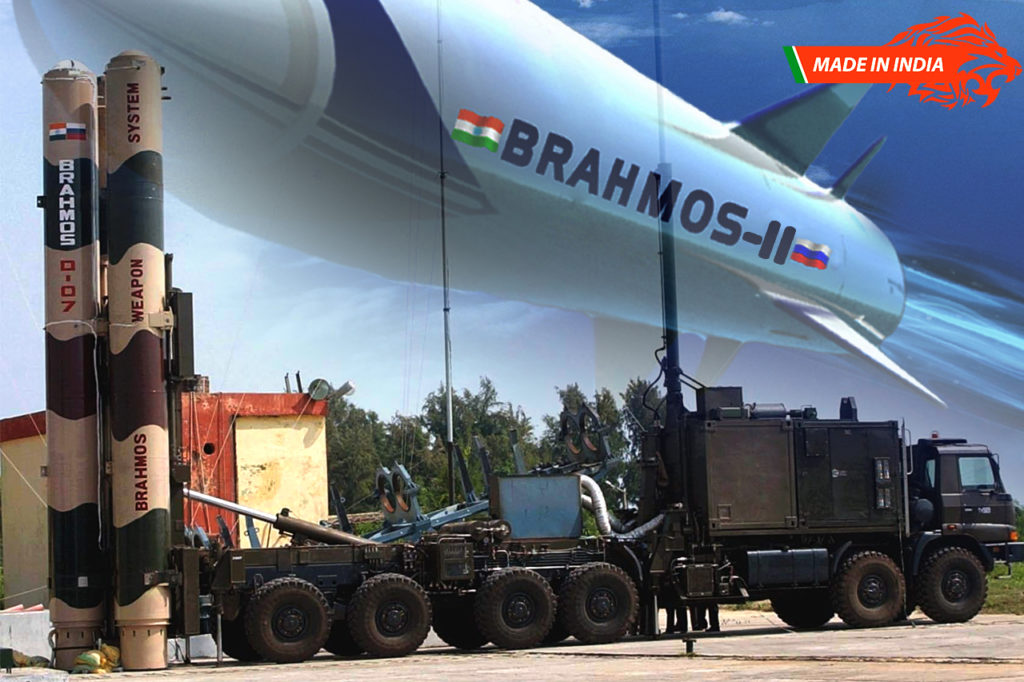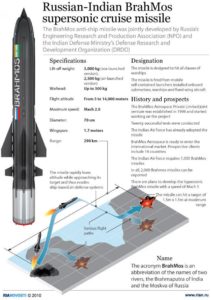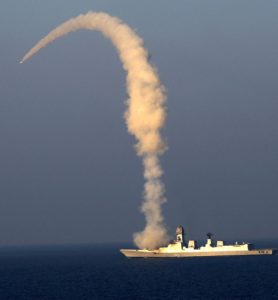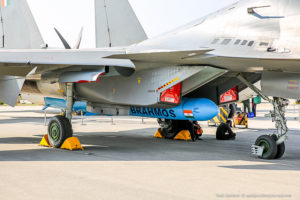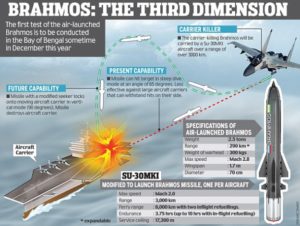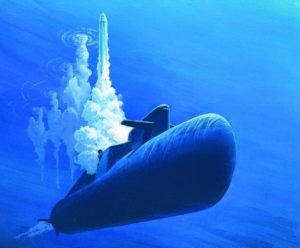History
The year 1983 India embarked on an ambitious programme to address the country’s defence requirements. This was the beginning of the Integrated Guided Missile Development Programme (IGMDP).
The project was focused on achieving independence in missiles programme by developing and producing a comprehensive range of missiles, including the intermediate range and short range ones.
It was after the Gulf War of 1990s, India felt increasingly necessary to equip the country with a cruise missile system.
India’s with its decades-old bonhomie with Russia, and with India’s unique balance in the Non-alignment policy, came to the forefront in developing the new missile system.
Dr. A P J Abdul Kalam, former President of India, also a missile technologist, and N V Mikhailov, Russia’s first Deputy Defence Minister, signed an Inter-Governmental Agreement in Moscow on February 12, 1998 which paved the way for BrahMos Aerospace -a joint venture between India’s Defence Research and Development Organisation (DRDO) and Russia’s NPO Mashinostroyenia (NPOM).
This partnership was forged to design, develop, manufacture and market world’s only supersonic cruise missile system – BRAHMOS.
As per the pact, India and Russia consented to jointly develop and produce the missile, with India having a holding of 50.5% share and Russia the other 49.5% share. On July 9, 1999, the first contract was signed under which the company received $123.75 million from the Russian government and $126.25 million from India. Work on the project began the same year in several specialized laboratories of DRDO and NPOM.
 The formation of the company set an example of integration of jointly developed high technology military product and its promotion in the world market through participation of several Indian and Russian institutions and industries.
The formation of the company set an example of integration of jointly developed high technology military product and its promotion in the world market through participation of several Indian and Russian institutions and industries.
The first successful launch of BRAHMOS took place on June 12, 2001. The missile was test fired from its land-based launcher at the Interim Test Range off the Chandipur coast in Orissa.
With years of research and development, Brahmos missile has undergone a number of test trials, meeting the requirements of its potential clients. The system is in service with the Indian Army, Indian Navy and Indian Air Force.
BrahMos Design and Features
BrahMos can be launched from land, sea and aerial platforms. The aircraft-launched variant (BrahMos A) is currently configured for the Sukhoi SU-30MKI aircraft of the Indian Air Force . It is equipped with a smaller booster and additional tail fins for greater stability during launch.
The ship and land-based BrahMos missiles can carry a conventional semi-armour-piercing warhead of 200kg, while the aerial variant can carry a 300kg warhead. These missiles can intercept surface targets as low as 10m in altitude.
The deep penetration capabilities of the BrahMos was tested successfully in November 2013 at the Pokhran test range in Rajasthan, India.
BrahMos Block-I, Block-II and Block-III
The land-variant BrahMos Block-I was successfully test fired twice in December 2004 and March 2007. The missile was inducted in the Indian Army in June 2007. Block II, the land attack variant of BrahMos, has also been developed. This missile was first tested in January 2009. In September 2010, the missile was test fired at supersonic speeds in a steep-dive mode and created a world record.
In December 2010, the BrahMos block-III+ version was successfully test-fired from the integrated test range at Chandipur, off the Orissa Coast, India.
A hypersonic version of the BrahMos is under development and expected to be ready for testing by 2017.
The Indian Army conducted the 32nd test-firing of the BrahMos missile from the integrated test range at Chandipur in July 2012. The test firing was part of development trials to evaluate newer subsystems added to the missile.
The land-based missile system consists of four to six mobile autonomous launchers, a mobile command post and mobile replenishment vehicle.
The ship-based BrahMos N1
This version of BrahMos is launched either from the inclined or vertical launch platform.
This missile system can be installed on frigates, corvettes, offshore patrol vessels and other types of vessels to attack sea and land-based targets.
BrahMos Aerospace has developed a universal vertical launcher module (UVLM) for the BrahMos N1 missile.
The UVLM can launch up to eight missiles to destroy a group of warships featuring modern anti-missile defence systems.
The first variant of BrahMos N1 has been installed on front-line warships of the Indian Navy from 2005. A highly maneuverable variant of the BrahMos missile was successfully test fired in October 2012 from INS Teg, a Talwar Class guided missile frigate of the Indian Navy.
The ship-based cruise missile consists of a fire control system, with high salvo launch capability and enhanced with an inertial navigation system.
BrahMos Air Launch Missile
BrahMos Aerospace has completed the development of an air launch variant. The aircraft launcher is being manufactured in cooperation with the Sukhoi Design Bureau, HAL and IAF. The launch platform is integrated in to the SU-30 MKI aircraft.
Russia signed a contract with India in December 2012, to integrate the BrahMos with the Su-30MKI aircraft for developing an air launch variant of the missile.
The Indian government has decided to lower the weight and strengthen the structure of the aircraft and rocket launcher of the BrahMos in order to make it more suitable for integration with the SU-30 MKI.
The first test for the air launch missile is carried out and is already operational with Indian Airforce.
BrahMos submarine launch missile
The submarine-launched BrahMos missile was successfully test fired on 20 March 2013 at Vishakhapatnam. India is the only country in the world to own a submarine launched supersonic cruise missile.
The missile can be fitted on a vertical launcher installed in the pressure hull of the submarine. It can be launched from submarines under a water depth of 40m-50m. The missile has a range of 290km and can travel at a speed of Mach 3.
BrahMos-2 hypersonic version
The hypersonic version of the BrahMos missile is under development. It can travel at a speed of Mach 5 to Mach 7. It will be the fastest hypersonic missile in the world, when fully developed.
The Moscow Institute of Aviation, Russia, and a team of scientists of IISc Bangalore will develop new technologies for the hypersonic version.
Propulsion
BrahMos is powered by a two-stage propulsion system. Initial acceleration is provided by a solid-propellant booster and supersonic cruise speed is provided by a liquid-fuelled ramjet system. The air-breathing ramjet propulsion is more fuel-efficient in comparison with conventional rocket propulsion. It provides the BrahMos with a longer range over similar missiles powered by rocket propulsion.
BrahMos Extended Range
The Defense Research Development Organization (DRDO), India, is expected to test fire an extended-range supersonic BrahMos cruise missile by the end of 2018, according to Indian government officials.
The Indian Air Force (IAF) will test fire the extended-range air-launched variant of the BrahMos, designated BrahMos-ER, from a Sukhoi Su-30 MKI multirole air superiority fighter jet. The new missile will purportedly be capable of hitting targets at a distance of up to 800 kilometers.
In March 2017, DRDO for the first time test fired a BrahMos-ER missile with a “much higher range than the current range of 290 km,” the Indian Ministry of Defense cryptically noted. Estimates put the range of the tested missile at 400-600 kilometers. Increasing the missiles’ range became possible after India joined the Missile Technology Control Regime in June 2016.
You may also like
-
IAF Aircraft Set Course For Exercise Eastern Bridge VII At Oman
-
IAF Set To Host The Indian Defence Aviation Exposition-II At Jodhpur
-
Defence Secretary to co-chair 5th India-Philippines Joint Defence Cooperation Committee meeting in Manila
-
Simultaneous Launch Of ‘malpe And Mulki’, Fourth And Fifth Ships Of Asw Swc (Csl) Project
-
Aatmanirbharta in Defence: MoD signs Contract with HAL for 240 AL-31FP Aero Engines for Su-30MKI Aircraft
